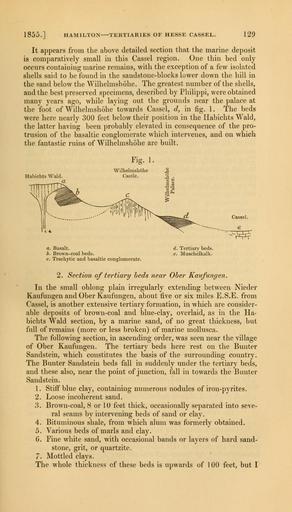MAKE A MEME
View Large Image

| View Original: | The_Quarterly_journal_of_the_Geological_Society_of_London_(12711568133).jpg (1828x3200) | |||
| Download: | Original | Medium | Small | Thumb |
| Courtesy of: | commons.wikimedia.org | More Like This | ||
| Keywords: The Quarterly journal of the Geological Society of London (12711568133).jpg 1855 HAMILTON TERTIARIES OF HESSE CASSEL <br> 129 <br> It appears from the above detailed section that the marine deposit <br> is comparatively small in this Cassel region One thin bed only <br> occurs containing marine remains with the exception of a few isolated <br> shells said to be found in the sandstone-blocks lower down the hill in <br> the sand below the Wilhelmshohe The greatest number of the shells <br> and the best preserved specimens described by Philippi were obtained <br> many years ago while laying out the grounds near the palace at <br> the foot of Wilhelmshohe towards Cassel d in fig 1 The beds <br> were here nearly 300 feet below their position in the Habichts Wald <br> the latter having been probably elevated in consequence of the pro- <br> trusion of the basaltic conglomerate which intervenes and on which <br> the fantastic ruins of Wilhelmshohe are built <br> Habichts Wald <br> Fie L <br> a Basalt <br> b Brown-coal beds <br> c Trachytic and basaltic conglomerate <br> Cassel <br> <br> d Tertiary beds <br> e Muschelkalk <br> 2 Section of tertiary beds near Ober Kavfungen <br> In the small oblong plain irregularly extending between Nieder <br> Kaufungen and Ober Kaufungen about five or six miles E S E from <br> Cassel is another extensive tertiary formation in which are consider- <br> able deposits of brown-coal and blue-clay overlaid as in the Ha- <br> bichts Wald section by a marine sand of no great thickness but <br> full of remains more or less broken of marine moUusca <br> The following section in ascending order was seen near the village <br> of Ober Kaufungen The tertiary beds here rest on the Bunter <br> Sandstein which constitutes the basis of the surrounding country <br> The Bunter Sandstein beds fall in suddenly under the tertiary beds <br> and these also near the point of junction fall in towards the Bunter <br> Sandstein <br> 1 Stiif blue clay containing numerous nodules of iron-pyrites <br> 2 Loose incoherent sand <br> 3 Brown-coal 8 or 10 feet thick occasionally separated into seve- <br> ral seams by intervening beds of sand or clay <br> 4 Bituminous shale from which alum was formerly obtained <br> 5 Various beds of marls and clay <br> 6 Fine white sand with occasional bands or layers of hard sand- <br> stone grit or quartzite <br> 7 Mottled clays <br> The whole thickness of these beds is upwards of 1 00 feet but I 35614701 110213 51125 Page 129 Text v 11 http //www biodiversitylibrary org/page/35614701 1855 Geological Society of London Biodiversity Heritage Library The Quarterly journal of the Geological Society of London v 11 1855 Geology Periodicals Smithsonian Libraries bhl page 35614701 dc identifier http //biodiversitylibrary org/page/35614701 smithsonian libraries Information field Flickr posted date ISOdate 2014-02-23 Check categories 2015 August 26 CC-BY-2 0 BioDivLibrary https //flickr com/photos/61021753 N02/12711568133 2015-08-26 21 00 46 cc-by-2 0 PD-old-70-1923 The Quarterly journal of the Geological Society of London 1855 Photos uploaded from Flickr by FĂŚ using a script | ||||